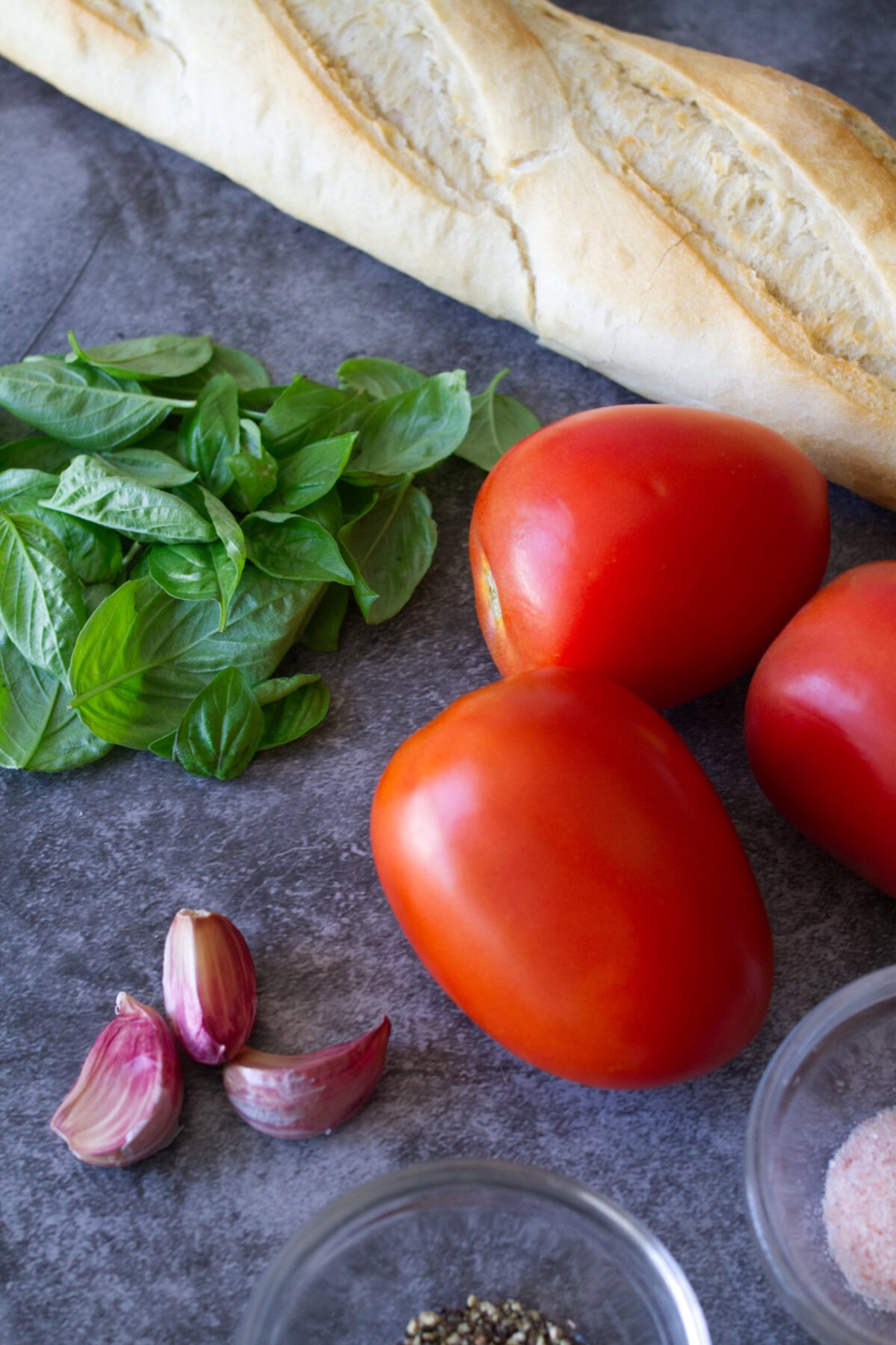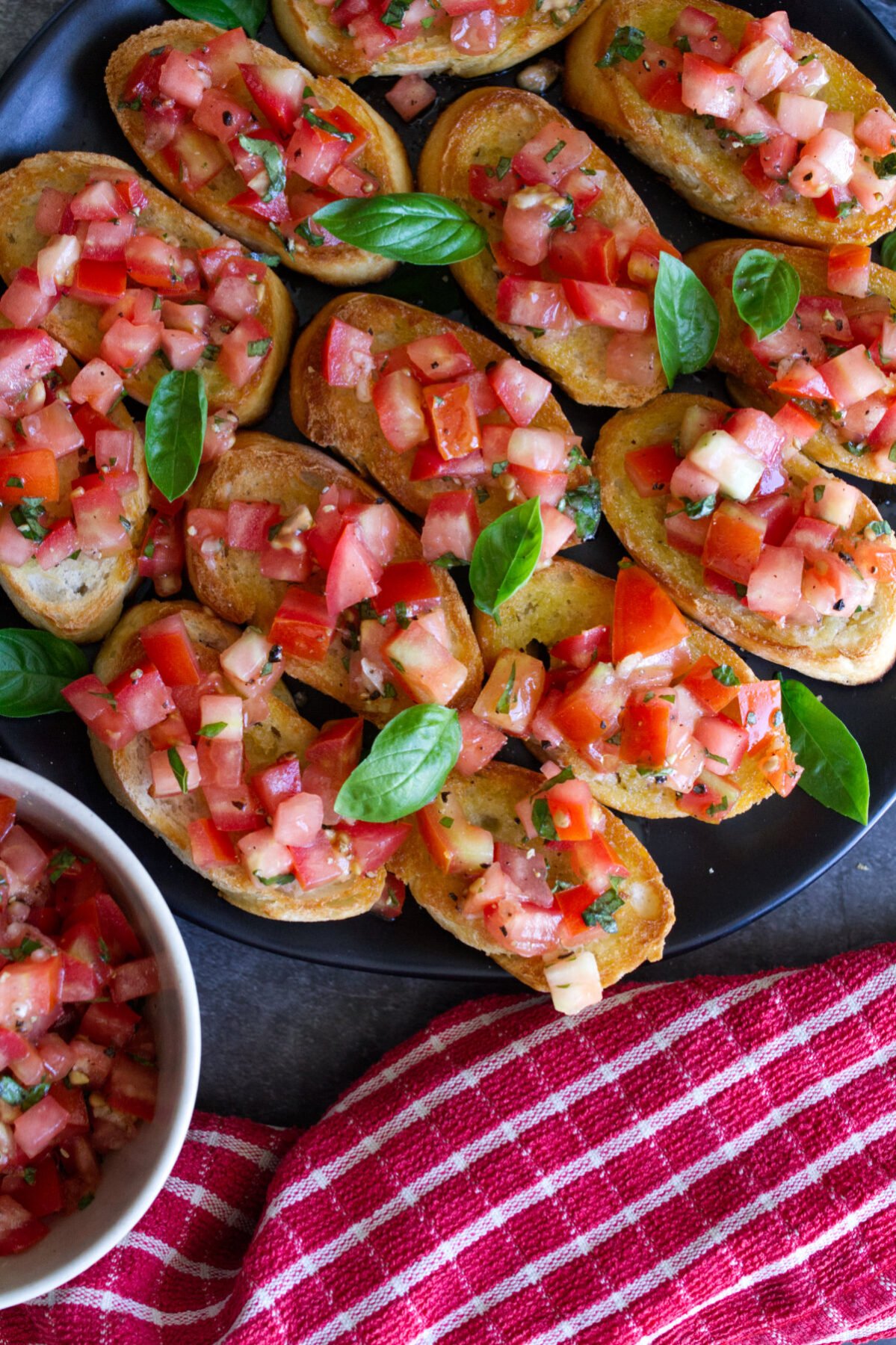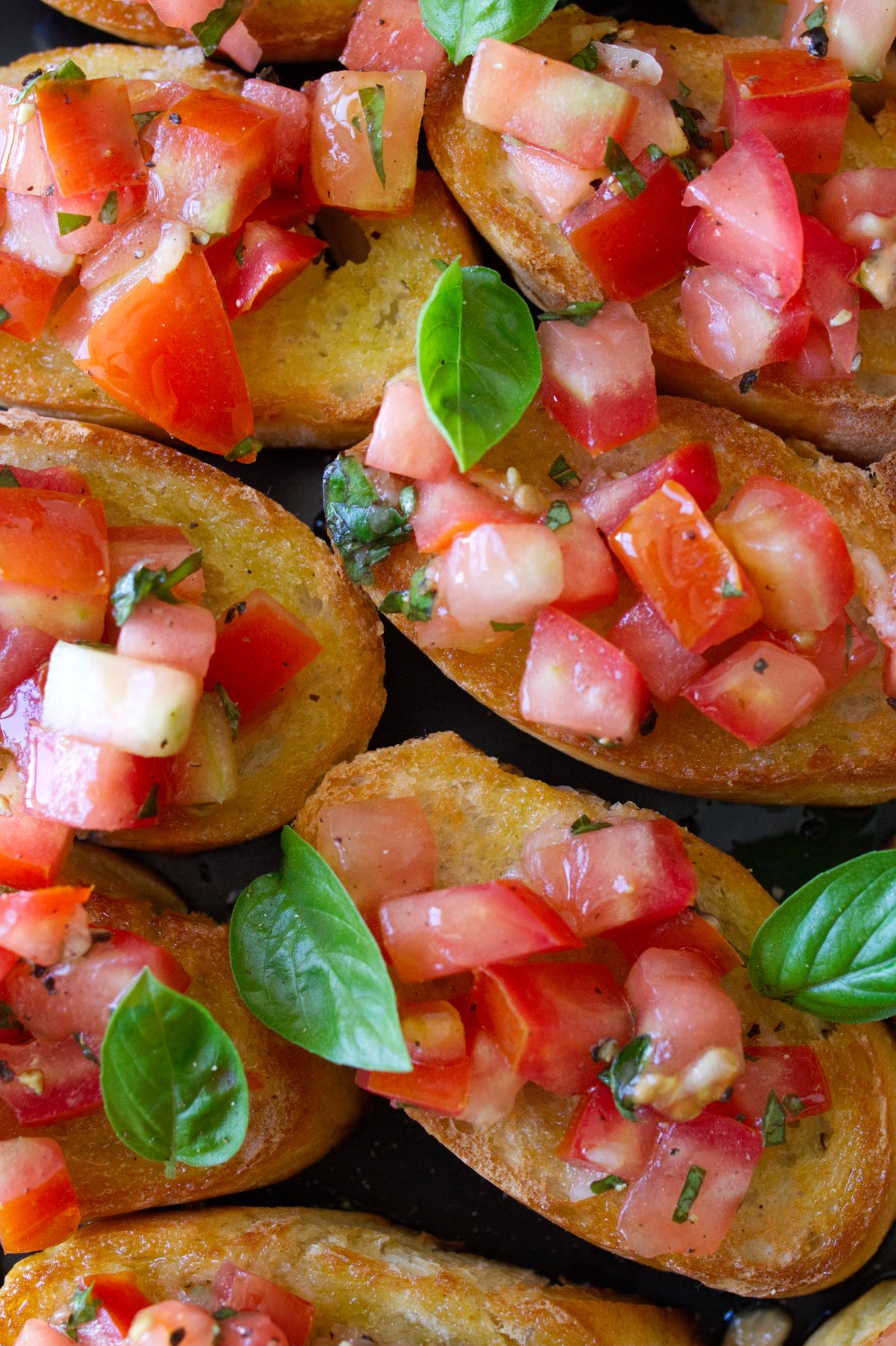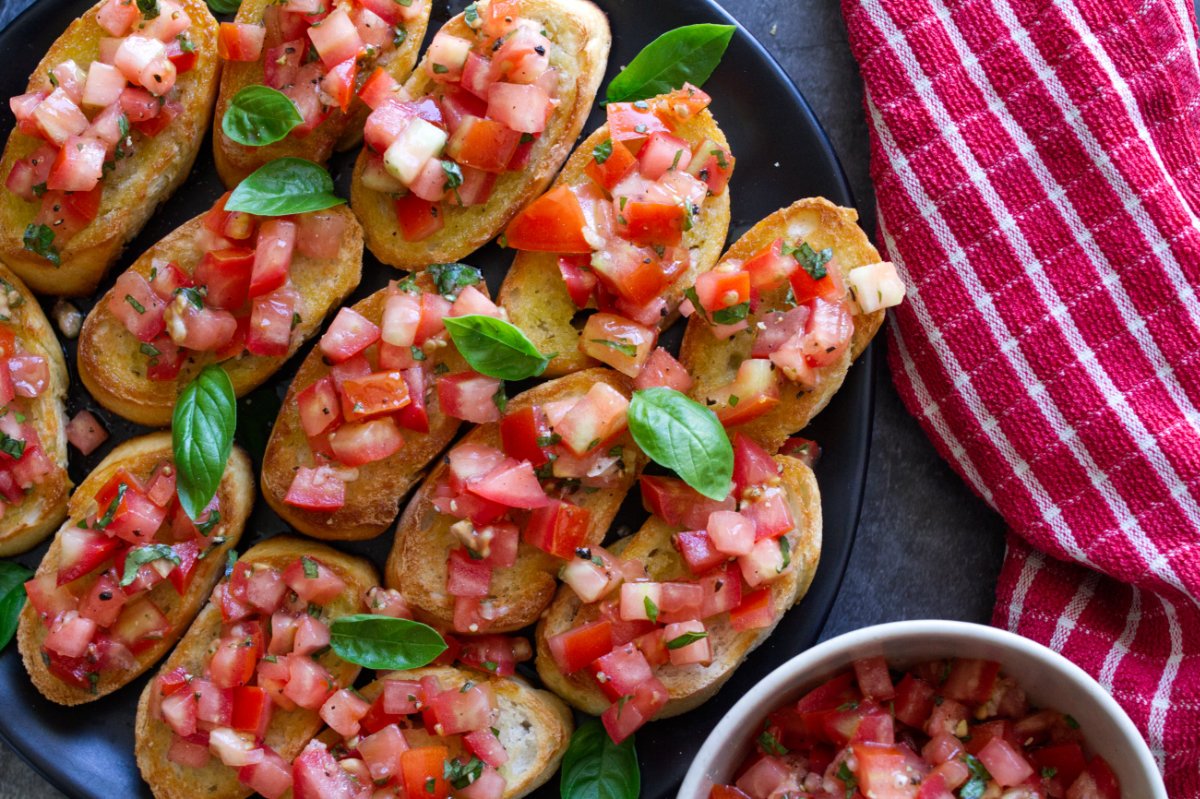This classic Italian Tomato Bruschetta recipe uses just a few fresh and high-quality ingredients to create a delicious antipasto (starter) dish. You’ll need fresh tomatoes, basil, garlic, good-quality olive oil (EVOO), and some salt and pepper for seasoning. Everything gets mixed together and then laid out on some lightly toasted bread like ciabatta or sourdough.
This recipe makes a tasty antipasto or snack to share with 4 people and is ready in under 20 minutes! With just 6 ingredients, this Italian Bruschetta is one of our favorite easy summer Mediterranean recipes!
– The quick & easy Italian antipasto that’s ideal for summer! –
Table of contents:
How to make Bruschetta
Bruschetta is not hard to make at all! In fact, it’s known for being a simple and quick dish to prepare that requires only a minimal amount of cooking (toasting the bread). The key to great Bruschetta lies in the quality of the ingredients and a few basic steps.
Basic Steps to Make Bruschetta:
- Choose Your Bread:
- Use a good-quality, rustic bread like ciabatta or a baguette.
- Slice the bread into pieces about 1/2 to 3/4 inch thick.
- Toast the Bread:
- Grill, toast, or bake the bread slices until they are golden and crispy on the edges but still soft in the middle.
- Optionally, rub a cut clove of garlic on the warm bread for added flavor.
- Prepare the Topping:
- Classic Tomato Topping:
- Dice ripe tomatoes.
- Mix with chopped fresh basil, a drizzle of extra virgin olive oil, salt, and pepper.
- You can also add a splash of balsamic vinegar for extra flavor.
- Classic Tomato Topping:
- Assemble:
- Spoon the tomato mixture onto the toasted bread.
- Serve immediately to keep the bread from becoming soggy.

Ingredients
Bread
- Ciabatta or Baguette
- 1 tablespoon extra virgin olive oil, (for brushing)
Tomato Topping
- 3 tomatoes (we used Roma/plum tomatoes)
- 2-3 garlic cloves, Minced
- Small handful of fresh basil leaves, roughly chopped
- 1 tbsp extra virgin olive oil (use the best quality you can afford)
- 1/4 tsp salt
- Black pepper (to taste)
Equipment
- Chopping board and knife
- Garlic Press
- Large Glass bowl
- Oven grill
- Large baking sheet
- Parchment paper (optional)
Instructions:
Tomato topping
- Start by dicing the tomatoes (remove the seeds if the tomatoes are extra juicy – See notes below in the article body). Strain off any excess quid before adding the diced tomatoes to a bowl.
- Add the minced garlic cloves, and chop the fresh basil leaves, and add them to the bowl with the diced tomatoes.
- Season to taste with salt and cracked pepper. Give everything a mix and then drizzle with a splash of good quality extra virgin olive oil.
- Mix again right before serving.
Bread
- Preheat the oven grill on high (250°C / 480°F).
- Slice bread into ½ inch (1cm) slices and add to a large baking tray lined with parchment paper.
- Brush one side of bread with oil then lightly grill until golden and crusty. Then flip the bread and brush again with some oil and lightly toast. It should work out around about 3 minutes on each side, but just be sure to keep an eye on the bread so it doesn’t burn.
- Optionally, Rub the surface of the bread lightly with the garlic for a little extra flavor.
Assemble & Serve!
- Right before serving, pile the tomato topping onto the bread.
- Drizzle with a splash of extra virgin olive oil and serve!
Cooking tips for making a classic Italian Bruschetta recipe?
In a classic Italian Bruschetta recipe, tomato seeds are typically not removed. The traditional preparation focuses on simplicity and preserving the natural flavor and texture of the tomatoes.
Key Points in Classic Italian Bruschetta:
- Tomato Variety: In Italy, ripe and flavorful tomatoes, often picked fresh, are used. These might include small plum or cherry tomatoes, which are less watery and have fewer seeds.
- Preparation: The tomatoes are usually diced or chopped finely, with their seeds and juices included. The juices contribute to the overall flavor and help to moisten the bread.
- Simplicity: Classic Italian cuisine often emphasizes minimal intervention with ingredients. The seeds and juices are part of the natural tomato, and removing them is generally not necessary unless the tomatoes are overly watery.
- Bread: Use a bread variety that doesn’t crumble too much and will not fall apart when loaded with toppings.

Origin of Bruschetta
Bruschetta has its origins in Italy and dates back to ancient Roman times. The word “bruschetta” comes from the Roman dialect verb “bruscare,” which means “to roast over coals” or “to toast.” This simple yet flavorful dish has a long history, rooted in the Italian tradition of using up stale bread.
Historical Background:
- Ancient Rome: Bruschetta is believed to have originated as a way for farmers and laborers to make use of stale bread. They would toast slices of bread over a fire, then rub them with garlic and drizzle them with olive oil. This simple preparation provided a satisfying and practical way to enjoy bread that was no longer fresh.
- Olive Oil Testing: In many parts of Italy, especially in the central regions like Tuscany, Lazio, and Umbria, Bruschetta was traditionally used as a way to taste the first press of the olive harvest. Farmers would toast bread, rub it with garlic, and drizzle it with fresh, high-quality olive oil to test its flavor and quality.
Evolution of Bruschetta
Over time, Bruschetta evolved from a simple snack into a popular antipasto (starter) dish. The addition of toppings like tomatoes, basil, and other ingredients likely came later, as tomatoes became more common in Italian cuisine after their introduction from the Americas in the 16th century.
Nowadays, Bruschetta gained international popularity in the late 20th century, particularly in North America and other parts of the world, where it is often served with a variety of creative toppings (see notes below for some regional variations on the classic Bruschetta). Despite its evolution and adaptation, the essence of Bruschetta remains rooted in its simple, rustic origins, and use of fresh and high-quality ingredients. .
Regional Variations:
- Tuscan Bruschetta (Fettunta): In Tuscany, bruschetta is often called “fettunta,” meaning “oily slice,” and is typically made with just garlic, olive oil, and salt. This version highlights the quality of the bread and olive oil.
- Roman Bruschetta: In Rome and surrounding areas, Bruschetta is often more elaborate, with various toppings like tomatoes, olives, cured meats, or cheeses.

Best tomatoes to use for making Bruschetta
For making Bruschetta, the best tomatoes to use are those that are ripe, juicy, and flavorful, with a good balance of sweetness and acidity. Of course, the choice will depend on personal preference and availability. If you want a classic, easy option, Roma tomatoes are often the go-to choice.
Here are some of the top choices:
1. Roma Tomatoes (Plum Tomatoes)
- Why: Roma tomatoes have a firm texture and fewer seeds, making them ideal for dicing and topping Bruschetta. Their flesh is dense and meaty, which helps prevent the Bruschetta from becoming too watery.
- Flavor: They have a mild sweetness with a slightly tangy taste.
2. Cherry Tomatoes
- Why: Cherry tomatoes are small, sweet, and juicy. Their size and vibrant flavor make them perfect for adding a burst of freshness to Bruschetta.
- Flavor: They tend to be sweeter and more intense in flavor compared to larger tomatoes.
3. Heirloom Tomatoes
- Why: Heirloom tomatoes come in various shapes, colors, and flavors, offering a rich, complex taste. They are juicy and have a depth of flavor that can elevate your Bruschetta.
- Flavor: They vary widely, but many are sweet, tangy, and rich in flavor.
4. Campari Tomatoes
- Why: Campari tomatoes are known for their deep red color, high sugar content, and low acidity. They are juicy and flavorful, making them a great option for Bruschetta.
- Flavor: Sweet and slightly tart, with a balanced flavor.

Remove the tomato seeds when making Bruschetta
There are a few main reasons why many will want to remove the seeds from the tomatoes when making Bruschetta. From preventing excess moisture, and improving the flavor and texture, to simply making your Bruschetta look better. For us, avoiding the dreaded soggy Bruschetta is number one reason for removing seeds from the tomatoes.
Soggy Bruschetta is definitely best avoided and the easiest way to do that is by removing the seeds from the tomatoes. Check your chosen tomatoes of choice and if they are very juicy, when you cut them in half, we suggest removing the seeds.
How to Remove Seeds:
- Cut the Tomatoes: Slice the tomatoes in half horizontally.
- Scoop Out the Seeds: Use a small spoon or your fingers to scoop out the seeds and the surrounding gel.
- Dice the Tomatoes: Once the seeds are removed, dice the tomato flesh as desired for your Bruschetta.
This small step can make a big difference in the final dish, giving you a more flavorful and visually appealing Bruschetta.
Do I need to remove the tomato seeds when making Bruschetta?
Short answer, nope! This really depends on what type of tomato you are using, how juicy they are, and of course your own preference. In fact, a classic Italian Bruschetta recipe is likely to not remove the seeds at all!

Best bread for making Bruschetta
The best bread for making Bruschetta is one that is sturdy, has a good crumb, and doesn’t fall apart when you bite into it. It’s also a good idea to use bread that toasts well without becoming too hard.
Here are a few suggestions:
1. Ciabatta
- Why: Ciabatta is a classic choice for Bruschetta. It has a light, airy crumb with large holes, and a crispy crust when toasted. The bread absorbs the tomato juices and olive oil well without becoming too soggy.
- Texture: Soft interior with a crunchy crust after toasting.
2. Baguette
- Why: A baguette works well for making smaller, bite-sized Bruschetta. Its thin, elongated shape allows you to cut it into perfect slices. It toasts to a nice crispness, providing a satisfying contrast to the juicy tomato topping.
- Texture: Dense and chewy, with a crispy crust when toasted.
3. Rustic Italian Bread (Pane Casareccio)
- Why: This traditional Italian bread has a thick, chewy crust and a dense, moist interior. It’s a great option for Bruschetta, especially for those who prefer a more substantial bite.
- Texture: Dense crumb with a sturdy crust, ideal for holding up to moist toppings.
4. Sourdough
- Why: Sourdough’s slightly tangy flavor adds an extra dimension to Bruschetta. Its sturdy texture ensures it won’t become overly soft when topped with juicy ingredients.
- Texture: Firm and chewy, with a crispy crust that complements the toppings.
5. Tuscan Bread (Pane Toscano)
- Why: This traditional bread is unsalted and pairs beautifully with the rich, savory flavors of Bruschetta toppings. It has a dense crumb and a thick crust, making it perfect for holding up to tomatoes and olive oil.
- Texture: Dense with a thick crust, providing a hearty base for Bruschetta.
Tips for Preparing the Bread:
- Slicing: Slice the bread about 1/2 to 3/4 inch thick. Thicker slices will hold the toppings better and have a more satisfying texture.
- Toasting: Grill or toast the bread slices until they are golden brown and crispy on the edges. This can be done in the oven, on a stovetop grill, or over an open flame.
Garlic Rub: After toasting, rub a clove of raw garlic over the surface of the warm bread. This imparts a subtle garlic flavor, enhancing the overall taste.

Nutrition Facts
| Servings: 4 | |
| Amount per serving | |
| Calories | 127 |
| % Daily Value* | |
| Total Fat 3.8g | 5% |
| Saturated Fat 0.5g | 3% |
| Cholesterol 0mg | 0% |
| Sodium 169mg | 7% |
| Total Carbohydrate 20.8g | 8% |
| Dietary Fiber 2.2g | 8% |
| Total Sugars 3.9g | |
| Protein 3.8g | |
| Vitamin D 0mcg | 0% |
| Calcium 47mg | 4% |
| Iron 1mg | 5% |
| Potassium 330mg | 7% |
| *The % Daily Value (DV) tells you how much a nutrient in a food serving contributes to a daily diet. 2,000 calorie a day is used for general nutrition advice. | |
More Mediterranean Appetizers:
- Tabbouleh (Tabouli)
- Beetroot Dip with Roasted Veg
- Greek Meatballs (Keftedes)
- Creamy Mediterranean Hummus
- Baba Ganoush (Smoky Eggplant)
- Warm Smoky Goat Cheese & Artichoke

How to make Bruschetta – Easy Summer Mediterranean Recipes
Equipment
- Chopping board and knife
- Garlic press
- large glass bowl
- Oven grill
- Large baking sheet
- Parchment paper (optional)
Ingredients
Bread
- Ciabatta or Baguette
- 1 tablespoon extra virgin olive oil (for brushing)
Tomato Topping
- 3 tomatoes we used Roma/plum tomatoes
- 2-3 garlic cloves Minced
- Small handful of fresh basil leaves roughly chopped
- 1 tbsp extra virgin olive oil use the best quality you can afford
- 1/4 tsp salt
- Black pepper to taste
Instructions
Tomato topping
- Start by dicing the tomatoes (remove the seeds if the tomatoes are extra juicy – See notes below in the article body). Strain off any excess quid before adding the diced tomatoes to a bowl.3 tomatoes
- Add the minced garlic cloves, and chop the fresh basil leaves, and add them to the bowl with the diced tomatoes.2-3 garlic cloves, Small handful of fresh basil leaves
- Season to taste with salt and cracked pepper. Give everything a mix and then drizzle with a splash of good quality extra virgin olive oil.1 tablespoon extra virgin olive oil, 1/4 tsp salt, Black pepper
- Mix again right before serving.
Bread
- Preheat the oven grill on high (250°C / 480°F).
- Slice bread into ½ inch (1cm) slices and add to a large baking tray lined with parchment paper.Ciabatta or Baguette
- Brush one side of bread with oil then lightly grill until golden and crusty. Then flip the bread and brush again with some oil and lightly toast. It should work out around about 3 minutes on each side, but just be sure to keep an eye on the bread so it doesn’t burn.1 tbsp extra virgin olive oil
- Optionally, Rub the surface of the bread lightly with the garlic for a little extra flavor.
Assemble & Serve!
- Right before serving, pile the tomato topping onto the bread.
- Drizzle with a splash of extra virgin olive oil and serve!
Video
Notes
Cooking tips for making a classic Italian Bruschetta recipe?
In a classic Italian Bruschetta recipe, tomato seeds are typically not removed. The traditional preparation focuses on simplicity and preserving the natural flavor and texture of the tomatoes.Key Points in Classic Italian Bruschetta:
- Tomato Variety: In Italy, ripe and flavorful tomatoes, often picked fresh, are used. These might include small plum or cherry tomatoes, which are less watery and have fewer seeds.
- Preparation: The tomatoes are usually diced or chopped finely, with their seeds and juices included. The juices contribute to the overall flavor and help to moisten the bread.
- Simplicity: Classic Italian cuisine often emphasizes minimal intervention with ingredients. The seeds and juices are part of the natural tomato, and removing them is generally not necessary unless the tomatoes are overly watery.
- Bread: Use a bread variety that doesn’t crumble too much and will not fall apart when loaded with toppings.

